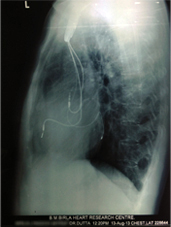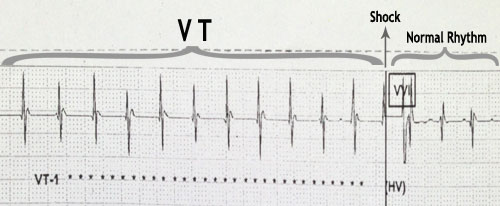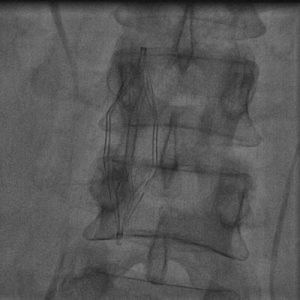Dr. Shuvo Dutta
Senior Consultant Cardiologist
MD(Cal), MRCP(UK), FRCP(London), FACC(USA)
Director – Interventional Cardiology,
Head Quality Assurance – Cathlab
B. M. Birla Heart Research Centre, Kolkata
Head Quality Assurance – Cathlab
B. M. Birla Heart Research Centre, Kolkata

Patient Case Studies
Weak Heart Pumping before CRT
Strong Heart Pumping after CRT
Case Type: CRT-P
Patient History
 46 years. 1st admission January 2013. Pulseless, unrecordable blood pressure, unconsciousness. CCU monitor – life threatning heart rhythm, which causes death(VT).
Rhythm restored in CCU by external electric shock. Life saved. Discharged on rhythm controlled medication with advice for urgent ICD implantation.
Readmitted 3rd August 2013, unconscious, no pulse, no BP, VT again shocked, saved. ICD implanted August 2013. Post discharge, at work, ICD activated by VT, shocked and patient saved outside hospital, not requiring further admission.
46 years. 1st admission January 2013. Pulseless, unrecordable blood pressure, unconsciousness. CCU monitor – life threatning heart rhythm, which causes death(VT).
Rhythm restored in CCU by external electric shock. Life saved. Discharged on rhythm controlled medication with advice for urgent ICD implantation.
Readmitted 3rd August 2013, unconscious, no pulse, no BP, VT again shocked, saved. ICD implanted August 2013. Post discharge, at work, ICD activated by VT, shocked and patient saved outside hospital, not requiring further admission. Case Type: CRT-D Implantation in Complex Situation
Patient History
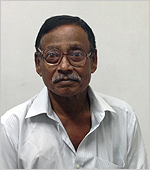 When the heart is displaced since birth to the opposite side (dextrocardio) CRT-D (CRT-P + ICD) implantation becomes a complex procedure.
This 57 years old gentleman with heart displaced to the right side as seen in this X-Ray was implanted with CRT-D device to prevent recurrent admission with heart failure. He was in end stage heart failure on maximal medication with past history of recurrent heart failure.
When the heart is displaced since birth to the opposite side (dextrocardio) CRT-D (CRT-P + ICD) implantation becomes a complex procedure.
This 57 years old gentleman with heart displaced to the right side as seen in this X-Ray was implanted with CRT-D device to prevent recurrent admission with heart failure. He was in end stage heart failure on maximal medication with past history of recurrent heart failure.
After CRT-D goes home walking and is well with no further heart failure. He was admitted recently once with shock delivered by ICD device converting life threatening rhythm (VT) to normal rhythm at home. Discharged same day.
Case Type: Prevention of Brain Stroke by Stenting
Patient History
 55 year old woman with temporary weakness of left arm and leg with immediate recovery was found to have blockage in right neck vessel (Right Carotid Artery). Small fat particle had temporarily dislodged into her brain circulation leading to the above symptoms. Larger particles usually lead to brain stroke.
55 year old woman with temporary weakness of left arm and leg with immediate recovery was found to have blockage in right neck vessel (Right Carotid Artery). Small fat particle had temporarily dislodged into her brain circulation leading to the above symptoms. Larger particles usually lead to brain stroke.
She underwent treatment by Stenting of Right Carotid Artery (Carotid Angioplasty) on 06.07.2012 with Distal Protection Device. Distal Protection Device prevents clots from entering into brain circulation during stenting causing brain stroke during stenting procedure.
She’s doing well till date with no subsequent recurrence of symptoms and no brain stroke.
Case Type: Importance of FFR in Complex Multivessel Disease
Patient History
 46 years old gentleman was referred for Bypass Surgery because of main three heart artery blockage.
46 years old gentleman was referred for Bypass Surgery because of main three heart artery blockage.
FFR study done on 08.04.2013. It confirmed that only single artery blockage was critical. Hence single vessel stenting was done in same sitting. Patient well.
For details of FFR, please visit the Patient FFR Details Page
Case Type: Indication of IVC Filter
Patient History
 56 yr old male was admitted with painful, unprovoked, severe swelling of left leg.
Dopler ultrasound confirmed clotting in left leg veins.
56 yr old male was admitted with painful, unprovoked, severe swelling of left leg.
Dopler ultrasound confirmed clotting in left leg veins.
Complication: Clot dislodgement from leg to lungs causing pulmonary embolism and sudden death.
Treatment: Clot buster injection was administered to dissolve clots in leg and IVC Filter was placed above leg veins (IVC) to trap particles dislodged during dissolving clots and prevent lung complication (Pulmonary Embolism) leading to sudden death during treatment.
Case Type: Treatment of abdominal aortic aneurysm by non-operative Endo-Prosthetic Device Insertion (AAA)
Patient History
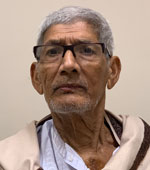 68 year old male with increasing abdominal and lower back pain. Gastroenterologist and Orthopaedic consultation were normal.
68 year old male with increasing abdominal and lower back pain. Gastroenterologist and Orthopaedic consultation were normal.
Diagnosis: Large abdominal aortic aneurysm diagonised by abdominal ultrasound. Above symptoms were suggestive of impending rupture of sac causing death.
Treatment: Stenting done with a self expanding stent covered by Teflon. This stent comes compressed and is passed from leg and released below kidney arteries within the sac from healthy segment of blood vessel above the sac to below the sac. Blood then flows through tube (covered Stent) preventing blood leaking into surrounding sac. The blood trapped in the sac clots and the sac shrinks and aneurysm disappears. Final results in video 4 confirms blood flowing from normal section of abdominal aorta flows through stent (covered tube) to both legs with no leakage into aneurysm sac.
Video 1
Video 2
Video 3
Video 4
Case Type: Transcatheter Aortic Valve Replacement (TAVR)
Patient History
 78 year old male was admitted with shortness of breath, fainting and fatigue. Past history of bypass surgery 18 years back. Check angiogram confirmed bypass grafts to be OK.
78 year old male was admitted with shortness of breath, fainting and fatigue. Past history of bypass surgery 18 years back. Check angiogram confirmed bypass grafts to be OK.
Diagnosis: New problem — Aortic valve the main door which allows blood from heart to pump to our body was blocked and now required valve replacement with open heart operation. Surgical team felt, TAVR device to be implanted (Non-surgical valve replacement) as risk of open heart surgery was high after bypass surgery and advanced age.
Treatment: TAVR done successfully from leg and patient discharged on January 2021 after 3 days. Last follow up January 2022 doing well..
Pictures and videos below gives us an idea about the implantation.
Original blocked Aortic valve first dilated with balloon to allow passage of artificial valve
Artificial Aortic valve advanced from leg vessel over wire
Artificial valve positioning confirmed and balloon mounted artificial valve deployed by inflating balloon, crushing disease valve
Balloon removed
Original blocked Aortic valve first dilated with balloon to allow passage oFinal injection confirmed no leaking in or around artificial valve. Also confirmed by Echo cardiogramf artificial valve
Case Type: ASD Closure
Patient History
 54 year old lady was diagnosed to have hole in her heart by Echo-cardiogram in Bangladesh, and was advised Device Closure.
54 year old lady was diagnosed to have hole in her heart by Echo-cardiogram in Bangladesh, and was advised Device Closure.
She presented with shortness of breath on effort.
Pictures and videos below gives us an idea about the procedure.
Catheter crossed through hole from chamber 1 to chamber 3 through hole in the heart
Wire introduced through catheter into chamber 1
Sheath introduced over wire to chamber 3 and wire removed
Device introduced through sheath into chamber 1 and withdrawn to close the hole
After checking for stability, device released
Get in Touch
Contact Info
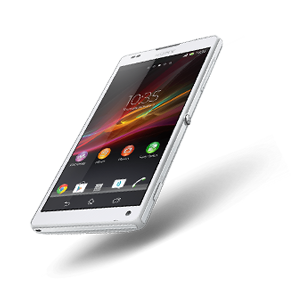
+91 98305 06845
Mobile (Secretary)

shuvodutta@yahoo.com
Doctor's Email

 42 yrs, active, office executive, gave up work for recurrent heart failure with frequent hospitalization. CRT-P device was implanted which improved her pumping action significantly.
42 yrs, active, office executive, gave up work for recurrent heart failure with frequent hospitalization. CRT-P device was implanted which improved her pumping action significantly.
